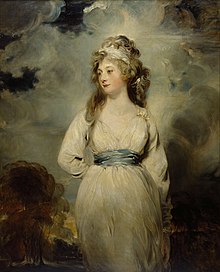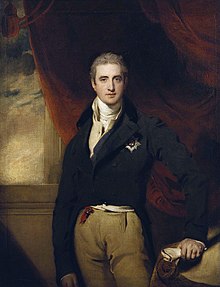Amelia Stewart, Marchioness of Londonderry

Amelia Anne Stewart, Marchioness of Londonderry ( February 20, 1772 - February 12, 1829 ), known between 1794 and 1821 as Emily Stewart, Lady Castlereagh , was the wife of the Irish politician Robert Stewart, 2nd Marquess of Londonderry . Born of noble birth and the wife of a prominent politician, she was an influential member of London's high society of the Regency era.
family
Emily Hobart was the daughter of John Hobart, 2nd Earl of Buckinghamshire and his second wife, Caroline Connolly. The Earl of Buckinghamshire was an English courtier and politician who was British Ambassador to Russia from 1762 to 1765 and Lord Lieutenant of Ireland from 1776 to 1880 .
Her maternal grandfather, William Connolly, was the heir to his uncle of the same name, Speaker of the Irish House of Commons in the early 18th century and extremely wealthy Irish landowner. Her uncle Thomas Conolly was a well-known Irish sportsman and married to Louisa Lennox, the daughter of Charles Lennox, 2nd Duke of Richmond and one of the four Lennox sisters famous for their beauty.
Your marriage to Stewart
In 1794 Emily Hobart married Robert Stewart , son of the Irish politician and landowner Robert Stewart, 1st Marquess of Londonderry . Her husband used the courtesy title Viscount Castlereagh from 1796 to 1821 , until he inherited the title after his father's death. The couple were very fond of each other, but they had no children. But they took care of their nephew Frederick Stewart , who was a son of Castlereagh's half-brother Charles and served in the army. Emily Stewart's great affection for her husband, combined with her fondness for traveling abroad, made her the ideal diplomatic wife. She was always ready to accompany her husband on even the most arduous journeys.
From 1820 Robert Stewart was increasingly exposed to attacks from political opponents. After all, for fear of physical attacks, he always carried a pistol with him, and rumors that were damaging to his reputation were spread about him. He was showing signs of paranoia . Stewart committed suicide on August 12, 1822 by cutting his throat with a letter opener. His wife had tried to hide his mental state from the outside; after his death, many of his friends and political colleagues reproached her for this.
After the death of her husband, Emily Stewart withdrew from the public for two years. She then resumed her previous social life until her death, which some friends of her husband criticized as "callous".
Social life
During the reign of George IV , Lady Castlereagh was, together with Lady Jersey , Dorothea von Lieven , Lady Cowper and other ladies, a patroness of the Almack’s Society Club, one of the first and most exclusive clubs for both sexes in London . In this role she had the greatest influence in British high society , as the patroness decided who was bon ton (dt. = Good tone ) when deciding who received a ticket for the club . It is said that Lady Castlereagh introduced the quadrille in London. The doors of the Almack’s closed at 11 p.m. sharp, and according to a popular anecdote, Lady Castlereagh personally denied the Duke of Wellington access to the club because he was a few minutes late.
In her country house, Loring Hall near North Cray , Lady Castlereagh kept a private zoo, with antelopes , kangaroos and a notoriously ill-tempered tiger , a popular attraction with her societies.
Individual evidence
- ^ The Cowan Inheritance . Public Records Office of Northern Ireland. September 7, 2006. Archived from the original on November 14, 2007. Retrieved on July 6, 2009.
- ^ A b Montgomery Hyde: The Strange Death of Lord Castlereagh William Heinemann Ltd. London 1959
- ^ Almack's Assembly Rooms , Britain Express . Accessed June 18, 2008.
- ↑ Regency Women of Character: Lady Castlereagh on egrom.com
Web links
- Lady Amelia Anne Hobart on thepeerage.com , accessed September 15, 2016.
- Amelia Anne Stewart (née Hobart), Marchioness of Londonderry (Lady Castlereagh) on npg.org.uk
| personal data | |
|---|---|
| SURNAME | Stewart, Amelia, Marchioness of Londonderry |
| ALTERNATIVE NAMES | Stewart, Emily, Viscountess Castlereagh |
| BRIEF DESCRIPTION | British nobles |
| DATE OF BIRTH | February 20, 1772 |
| DATE OF DEATH | February 12, 1829 |
